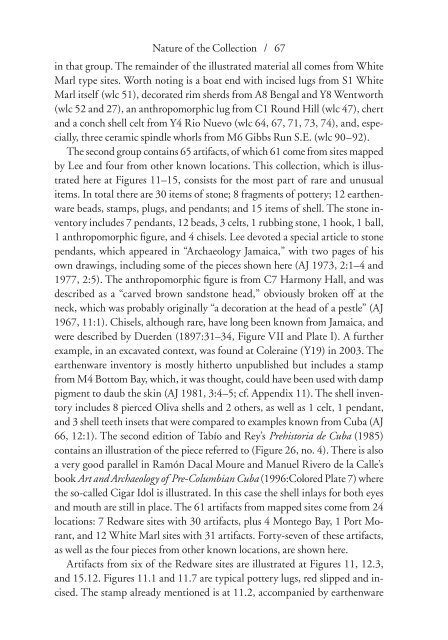Pre-Colombian Jamaica: Caribbean Archeology and Ethnohistory
by Phillip Allsworth-Jones
by Phillip Allsworth-Jones
You also want an ePaper? Increase the reach of your titles
YUMPU automatically turns print PDFs into web optimized ePapers that Google loves.
Nature of the Collection / 67<br />
in that group. The remainder of the illustrated material all comes from White<br />
Marl type sites. Worth noting is a boat end with incised lugs from S1 White<br />
Marl itself (wlc 51), decorated rim sherds from A8 Bengal <strong>and</strong> Y8 Went worth<br />
(wlc 52 <strong>and</strong> 27), an anthropomorphic lug from C1 Round Hill (wlc 47), chert<br />
<strong>and</strong> a conch shell celt from Y4 Rio Nuevo (wlc 64, 67, 71, 73, 74), <strong>and</strong>, especially,<br />
three ceramic spindle whorls from M6 Gibbs Run S.E. (wlc 90–92).<br />
The second group contains 65 artifacts, of which 61 come from sites mapped<br />
by Lee <strong>and</strong> four from other known locations. This collection, which is illustrated<br />
here at Figures 11–15, consists for the most part of rare <strong>and</strong> unusual<br />
items. In total there are 30 items of stone; 8 fragments of pottery; 12 earthenware<br />
beads, stamps, plugs, <strong>and</strong> pendants; <strong>and</strong> 15 items of shell. The stone inventory<br />
includes 7 pendants, 12 beads, 3 celts, 1 rubbing stone, 1 hook, 1 ball,<br />
1 anthropomorphic figure, <strong>and</strong> 4 chisels. Lee devoted a special article to stone<br />
pendants, which appeared in “Archaeology <strong>Jamaica</strong>,” with two pages of his<br />
own drawings, including some of the pieces shown here (AJ 1973, 2:1–4 <strong>and</strong><br />
1977, 2:5). The anthropomorphic figure is from C7 Harmony Hall, <strong>and</strong> was<br />
described as a “carved brown s<strong>and</strong>stone head,” obviously broken off at the<br />
neck, which was probably originally “a decoration at the head of a pestle” (AJ<br />
1967, 11:1). Chisels, although rare, have long been known from <strong>Jamaica</strong>, <strong>and</strong><br />
were described by Duerden (1897:31–34, Figure VII <strong>and</strong> Plate I). A further<br />
example, in an excavated context, was found at Coleraine (Y19) in 2003. The<br />
earthenware inventory is mostly hitherto unpublished but includes a stamp<br />
from M4 Bottom Bay, which, it was thought, could have been used with damp<br />
pigment to daub the skin (AJ 1981, 3:4–5; cf. Appendix 11). The shell inventory<br />
includes 8 pierced Oliva shells <strong>and</strong> 2 others, as well as 1 celt, 1 pendant,<br />
<strong>and</strong> 3 shell teeth insets that were compared to examples known from Cuba (AJ<br />
66, 12:1). The second edition of Tabío <strong>and</strong> Rey’s <strong>Pre</strong>historia de Cuba (1985)<br />
contains an illustration of the piece referred to (Figure 26, no. 4). There is also<br />
a very good parallel in Ramón Dacal Moure <strong>and</strong> Manuel Rivero de la Calle’s<br />
book Art <strong>and</strong> Archaeology of <strong>Pre</strong>- Columbian Cuba (1996:Colored Plate 7) where<br />
the so- called Cigar Idol is illustrated. In this case the shell inlays for both eyes<br />
<strong>and</strong> mouth are still in place. The 61 artifacts from mapped sites come from 24<br />
locations: 7 Redware sites with 30 artifacts, plus 4 Montego Bay, 1 Port Morant,<br />
<strong>and</strong> 12 White Marl sites with 31 artifacts. Forty- seven of these artifacts,<br />
as well as the four pieces from other known locations, are shown here.<br />
Artifacts from six of the Redware sites are illustrated at Figures 11, 12.3,<br />
<strong>and</strong> 15.12. Figures 11.1 <strong>and</strong> 11.7 are typical pottery lugs, red slipped <strong>and</strong> incised.<br />
The stamp already mentioned is at 11.2, accompanied by earthenware


















